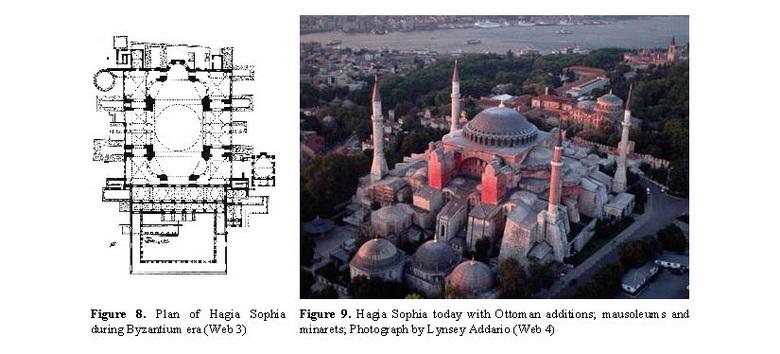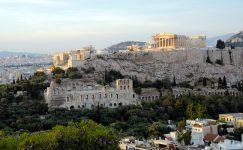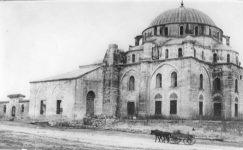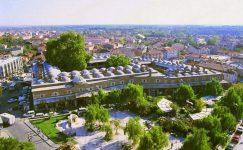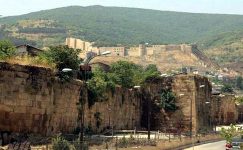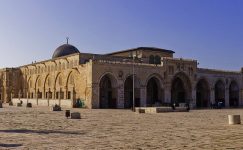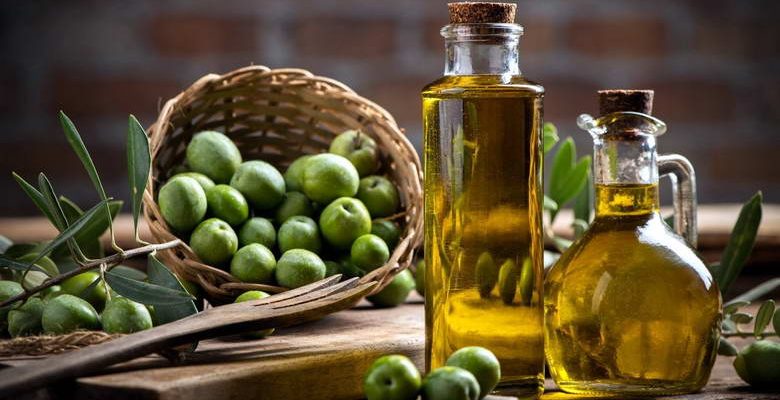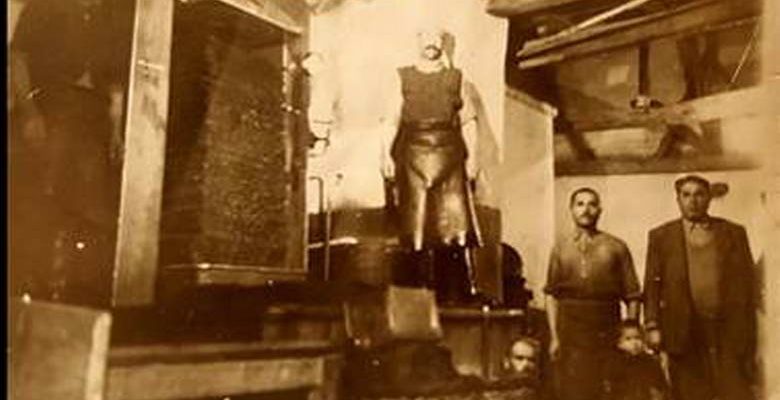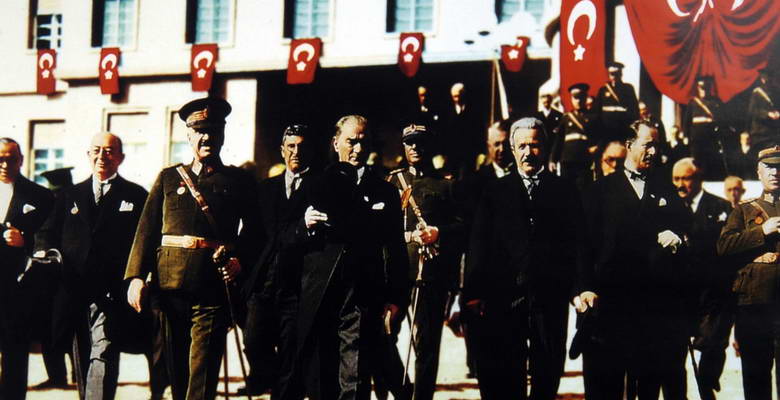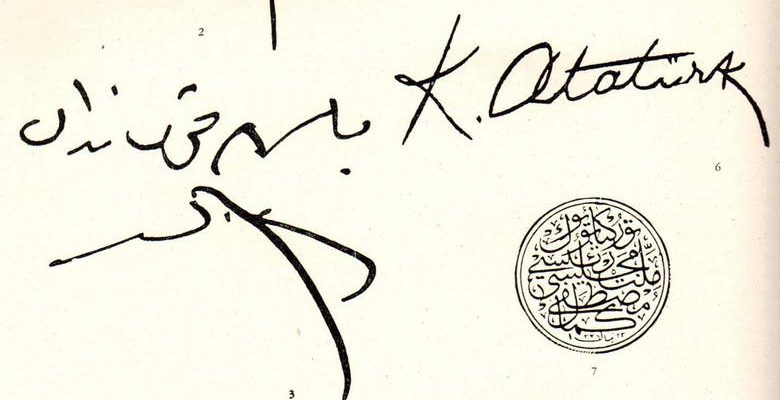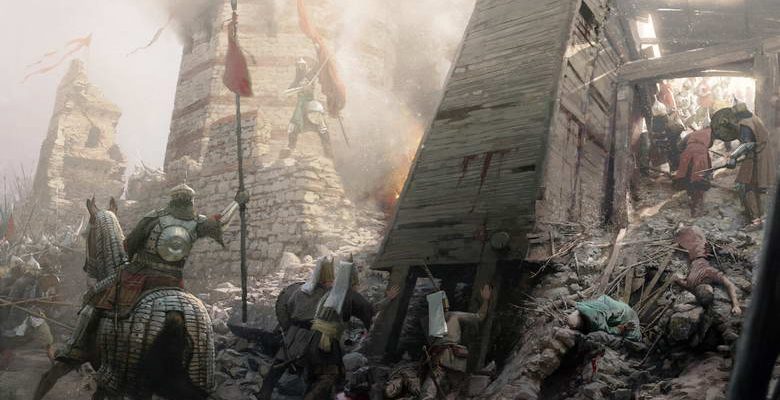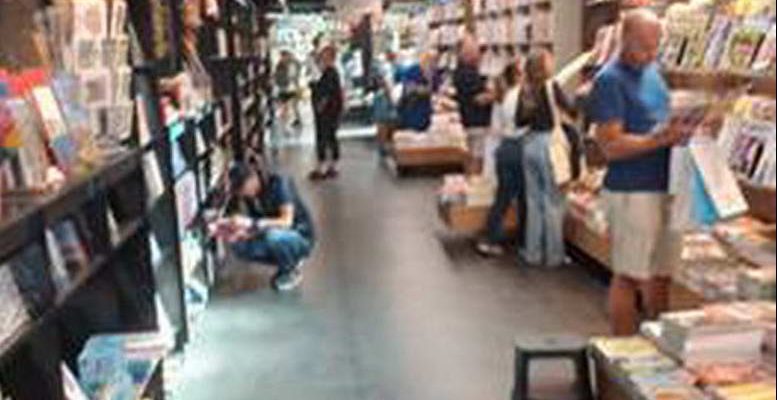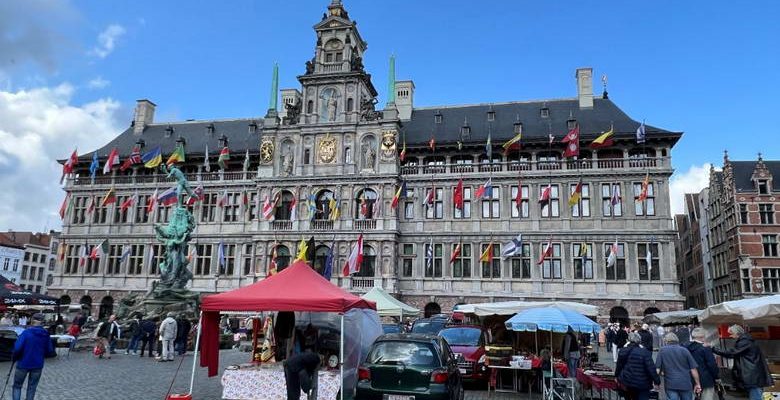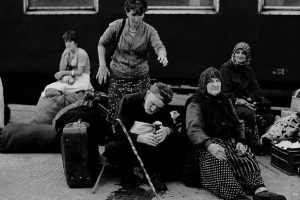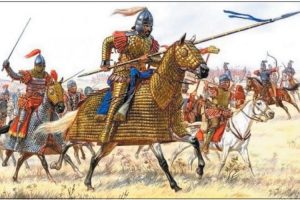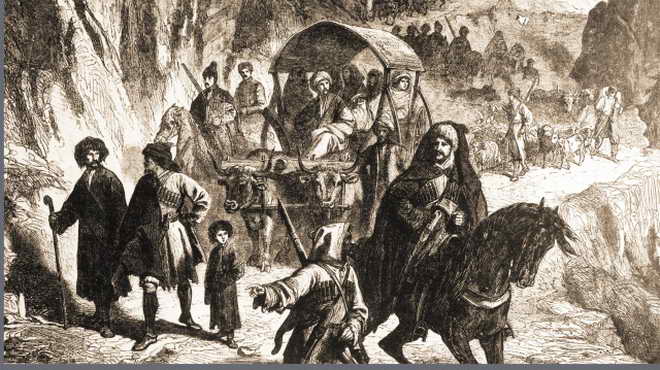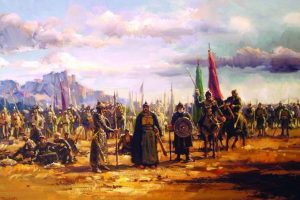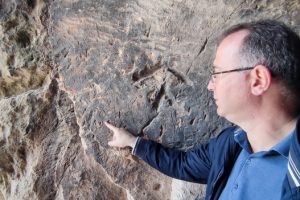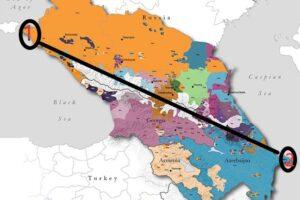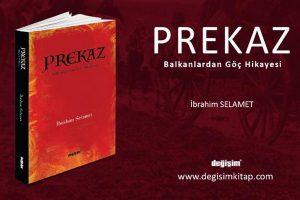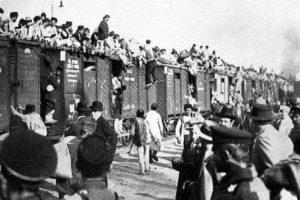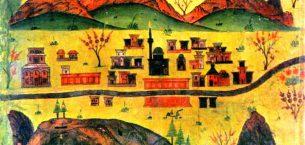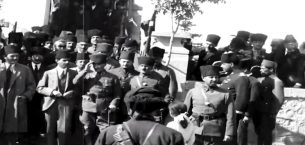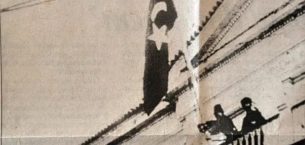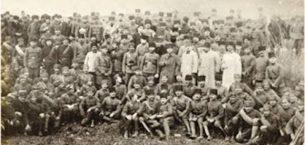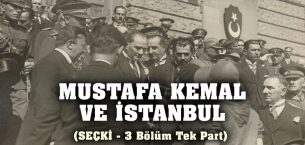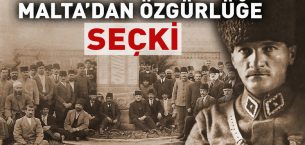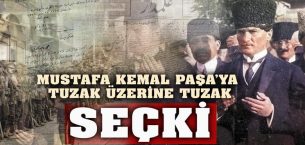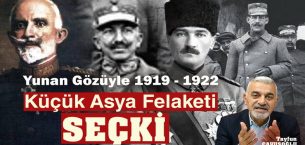
| Conservation of dome mosaics of Hagia Sophia in Istanbul |
- A.Gülçin KÜÇÜKKAYA /
Bu Yazıda - Konu İçi Ara Başlıklar
- Ayse Gulcin Kucukkaya(1), Sazuman Sazak(2)
Abstract
It can not be seen any other diverted building that conserves the original name. The importance of Hagia Sophia (Turkish; Ayasofya) was political and religious during the Ottoman Empire era. It was conserved and used willingly for many years by Ottoman Turks. Sultan Mohammed the conqueror designed a booklet (Waqfie) which has got the richest incomes for the management of the building. According to these original financial documents, incomes will be used not only for the maintenance of the old building which needs consolidation and restoration but also afford for the new constructions to support.
Hagia Sophia was beautifully decorated with mosaics within the centuries during Byzantine period. In this paper, mosaic decoration will be investigated on the conservation and tourism point of view.
Keywords conservation, Hagia Sophia, mosaics, dome, Constantinople, Istanbul
1. INTRODUCTION
Hagia Sophia (from the Greek: Ἁγία Σοφία, “Holy Wisdom”; Latin: Sancta Sophia or Sancta Sapientia; Turkish: Ayasofya) was an Orthodox Patriarchal Basilica (Web 1) from the date of its dedication in 360 until 1453. It served as the cathedral of Constantinople except between 1204 and 1261 when it was converted to a Roman Catholic cathedral under the Latin Patriarch of Constantinople of the Western Crusader established Latin Empire. The building was used as a mosque from 1453 until 1934. Today, it has been using as a museum since 1935.
It was beautifully decorated with mosaics, which depicts Virgin Mary, Jesus, saints and emperors or empresses, within the centuries during several Byzantine periods. The known ones start from the reestablishment of Orthodoxy and reach its height during the reigns of Basil I and Constantine VII (Web 1). During the fourth crusade in 1204, Latin Crusaders sacked many Byzantine buildings including Hagia Sophia. Many beautiful mosaics were removed and shipped to Venice. After the Ottoman occupation of Constantinople in 1453, with the transition of Hagia Sophia into mosque, the mosaics were covered with plaster. In 1847, with Fosatti brothers’ restoration, the mosaics got uncovered and were copied for record (Web.2). In 1934, Great leader Mustafa Kemal Ataturk ordered that Hagia Sophia would become a museum, the recovery of mosaics and restoration expanded then.
2. CHRONOLOGICAL TABLE OF HAGIA SOFHIA
2.1. Constantinople and Hagia Sophia in Byzantine Time (Fig.1, 2)
Constantinople was founded at 324 and became the commercial nucleus of the known world in a very short time (Jackson, 1920). From east and west travellers and traders, princes and painters, flocked to the new city for hundreds of years. Constantinople and the Church of Santa Sophia received the tribute due to it from a mighty empire. It was the wealthiest and most splendid city in the world (Stewart, 1947).)
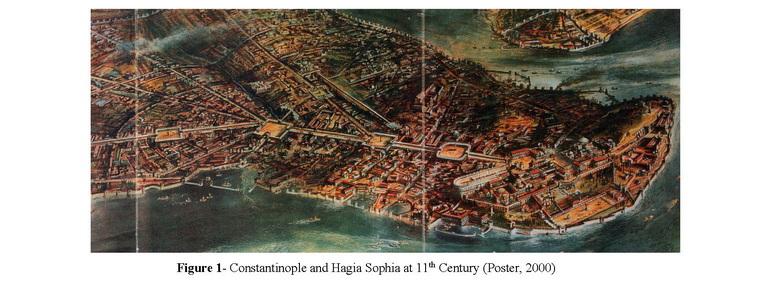 The first St. Sophia, known simply as the Great Church, was built by Constantine or, more probably, by Constantine II, and was dedicated in 360 (Jackson, 1920). It was a timber-roofed basilica which burned in 404. A second church was built, and this too, was destroyed by fire in the course of the Nika Riot in 532. The new church was rebuild and ceremonially dedicated in 537 by Justinian. The architects were Anthemius of Tralles, a famous mathematician and Isodore of Miletus (Mango, 1978). Hagia Sophia was thrown down by an earthquake in 975 and rebuilt in six years by Basil II. The Eastern arch with part of the dome and the adjoining semi-dome fell in 1346, and were rebuilt before 1356 (Jackson, 1913).
The first St. Sophia, known simply as the Great Church, was built by Constantine or, more probably, by Constantine II, and was dedicated in 360 (Jackson, 1920). It was a timber-roofed basilica which burned in 404. A second church was built, and this too, was destroyed by fire in the course of the Nika Riot in 532. The new church was rebuild and ceremonially dedicated in 537 by Justinian. The architects were Anthemius of Tralles, a famous mathematician and Isodore of Miletus (Mango, 1978). Hagia Sophia was thrown down by an earthquake in 975 and rebuilt in six years by Basil II. The Eastern arch with part of the dome and the adjoining semi-dome fell in 1346, and were rebuilt before 1356 (Jackson, 1913).
2.2. Istanbul and Ayasofya in the Sultan Mohammed Era (Fig.3).
The Crusader conquest of 1203-1204 had left Constantinople in a state of decay. All the monuments of the city that were historical value had been devastated and its priceless treasures had been looted. During this looting the most important monuments had been burnt down and many others destroyed (Ulgen, 1939). The Sacred Palace of Byzantium had been razed during those dreadful days. Such monuments as the Hippodrome, Saint Sophia, the Church of the Holy Apostles (which were the pride of the Eastern Roman Empire and which were full of valuable works of arts), and the Emperor’s tombs had been plundered (Ulgen, 1939).
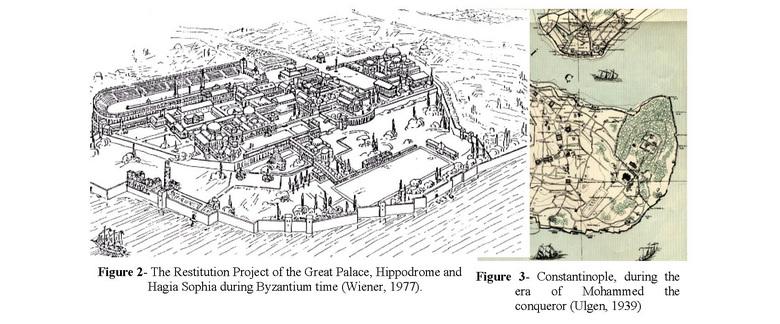 The Turks found in Istanbul about fifty church-most of which were in ruins-some government halls, and ruins of social institutions (which had crumbled away because of lack of attention), and also bad roads and abandoned places (Fig. 3). Underground watercourses, cisterns, and the columns that once adorned the squares, the bronze decorations of which had been plundered by Crusaders, were the only strong and protected remnants (Ulgen, 1939).The Ottoman Turks started to improve the city immediately to create their new capital.
The Turks found in Istanbul about fifty church-most of which were in ruins-some government halls, and ruins of social institutions (which had crumbled away because of lack of attention), and also bad roads and abandoned places (Fig. 3). Underground watercourses, cisterns, and the columns that once adorned the squares, the bronze decorations of which had been plundered by Crusaders, were the only strong and protected remnants (Ulgen, 1939).The Ottoman Turks started to improve the city immediately to create their new capital.
3. CONSERVATION OF HAGIA SOPHIA
3.1. Conservation studies during Byzantine Era
It has been called a domed basilica because it has a longitudinal axis and row of columns on either side of the nave (Mango, 1978). The Greeks, however, with complete mastery of form, evolved in Sancta Sophia, with domes and semi-domes, a splendid system of construction with contained the thrust and counter- thrust within the building itself. The great dome is supported with so little apparent effort, like canopy in space that Procopius, contemporary with its construction, suggested that it seemed to hang by a golden cord from heaven (Stewart, 1947).
The man chiefly responsible, Anthemios of Tralles, was not an architect but a professor of solid geometry with, as far as we know, no building experience whatever. His partner, Isidore of Miletus, had, it is true, written a treatise on vaulting, but is chiefly known as a commentator on Euclid. The construction of this extraordinary building, therefore, represents the practical application of an elaborate theory worked out on paper (Murray, 1969).
It was begun to be built by the Emperor Justinian in the year 532. Twenty-one years later the first of many earthquakes brought down a part of the eastern arch and dome, but Justinian speedily repaired the damage (Hamilton, 1956). In 989 a severe earthquake caused part of the west arch and dome to collapse. The architect who completed the restoration was an Armenian (Hamilton, 1956).
 In 1204 it suffered grievous despoliation at the hands of the predatory soldiers of the Fourth Crusade (Hamilton, 1956). An incalculable number of gold and silver ornaments were looted and carried away to the West, although the greater part, as Gibbon mournfully reflects, must have been lost or destroyed in the camps (Hamilton, 1956). In 1317 it needed to be strengthened by Emperor Anddronicus Palaeologus (Hamilton, 1956). It was affected from an earthquake in 1347 again (Hamilton, 1956).
In 1204 it suffered grievous despoliation at the hands of the predatory soldiers of the Fourth Crusade (Hamilton, 1956). An incalculable number of gold and silver ornaments were looted and carried away to the West, although the greater part, as Gibbon mournfully reflects, must have been lost or destroyed in the camps (Hamilton, 1956). In 1317 it needed to be strengthened by Emperor Anddronicus Palaeologus (Hamilton, 1956). It was affected from an earthquake in 1347 again (Hamilton, 1956). 
3.2. Restorations of Ayasofya during Ottoman era
Immediately after the conquest of Constantinople in 1453, Mohammed II converted Hagia Sophia Church into the Ayasofya Mosque. It became the first imperial mosque of Istanbul. Before 1481 a small minaret was erected on the SW corner of the building, above the stair tower. The second minaret was built on the SE corner by Sultan Bayezit II. During the reign of Selim II (1566–1577), the building started showing signs of fatigue and was extensively strengthened with the addition of structural supports to by the great Ottoman architect Mimar Sinan. In addition to strengthening the old Byzantine structure, Sinan built the two additional large minarets at the western end of the building (NW and NE). Thus, sensitive structure of Hagia Sophia was settled strongly by diagonal loads of four minarets at the four corners (Fig. 4-7).
Mausoleums of Selim II (1576-7), Murad III (1574–1595), the octagonal mausoleum of Mehmed III (1595–1603) and his Valide (1608) were built next to the building, and the baptistery converts into a mausoleum in 1916. All this new additions around building can be taken in to consideration as the additional supporting elements for the well sitting of the old fragile structure of Hagia Sophia to create more stable old structure.
The most important restoration of the Ayasofya was ordered by Sultan Abdülmecid and completed by eight hundred workers between 1847 and 1849, under the supervision of the Swiss-Italian architect brothers Gaspare and Giuseppe Fossati. The brothers consolidated the dome and vaults, straightened the columns, and revised the decoration of the exterior and the interior of the building. The mosaics in the upper gallery were cleaned. This was a notable restoration in the history of the original structure (Hamilton, 1956).
4. MOSAIC DECORATION IN BYZANTION ARCHITECTURE AND HAGIA SOPHIA
4.1. Mosaic decoration at Byzantine Architecture
The Byzantine mosaic is made of glass. According to Pliny the art of glass mosaic is as old as the time of Augustus. Under the later Empire it seems to have been practised chiefly, if not exclusively, by Greeks, and in their hands it attained a degree of perfection that has never been surpassed. A close study of their technique discovers various refinements of execution, from ignorance or disregard of which most modern attempts have lamentably failed (Jackson, 1913).
In Byzantine mosaic the treatment is board and simple: the ground, whether of ultramarine blue or gold, is left largely uncovered; the figures are treated very flatly, shaded with restraint, and sometimes defined on one side and in folds of drapery by dark lines. Those of the 5th century are drawn with considerable remains of the old classic grace, which in Justinian’s time was in a measure lost, the figures of that time being often very ill drawn, not to say barbarous, though preserving all the beauty of colour to which the art owes its principal charm. Little regard is paid to architectural lines. As a rule the mosaic of the wall is carried round the edges of arches and under their soffit, without any hard and sharp line in stonework to define their form. This helps to give that strange, archaic, undersigned effect of which we are conscious in the interior of S. Mark’s at Venice (Jackson, 1913). Full display of colour, and especially to get the greatest value of the gold which plays so important a part in the treatment, mosaic is used preferably on curved surfaces such as apses and domes and vaults, where the gold passes from a brilliant glitter in the full light to a lovely soft and liquid brown in the half lights and shades (Jackson, 1913).
The superiority of mosaics thus placed to the same on a flat surface may be appreciated by comparing the brilliancy of those in the apses and domes at Ravenna, with that of the processions on each side of the nave of S. Apollinare Nuovo in the same city. It would take too long to dwell on the various minor technicalities to which the old mosaics owe so much; on the ingenuity with which the workman would stick his little half inch or quarter inch cube of glass, always with the fractured edge to the front, into the cement so as to catch the light at the best angle; how he would follow the outline of the figure in arranging the tesserae of the ground, and employ various other devices which occur only to the actual handicraftsman or to those who are in the habit of designing for and with him. Working on the spot, with only a few lines traced on the surface to guide him, it is evident the mosaic artist would have something of the freedom of the fresco painter (Jackson, 1913).
4.2. Mosaics of Hagia Sophia
The stupendous dome of Hagia Sophia and soaring vaults hang over the vast extent of nave like the canopy of heaven, and the glories of the unseen realm are adorned in the golden mosaics and shimmering marbles which cover vaults and walls (Hamilton, 1956). Many of the mosaics were of a non- representation character and of great charm in their design and colour. The gleaming golden surfaces of the aisle-vaults were adorned with rosettes, stars, geometric bands and cross (Hamilton, 1956).
Following the building’s conversion into a mosque in 1453, the dome, vaults and part of the walls were embellished with mosaics are used to covered by the Turks, with plaster, due to Islam’s ban on representational imagery. In 1847–49, the building was restored by two Swiss Italian Fossati brothers, and Sultan Abdülmecid allowed them to also document any mosaics they might discover during this process. This work included covering the previously uncovered faces of two seraphim mosaics located in the centre of the building. The building currently features a total of four of these images and two of them are restorations in paint created by the Fossatis to replace two images of which they could find no surviving remains. In other cases, the Fossatis recreated damaged decorative mosaic patterns in paint, sometimes redesigning them in the process. The Fossati records are the primary sources about a number of mosaic images now believed to have been completely or partially destroyed in an earthquake in 1894. These include a great mosaic of Christ Pantocrator in the dome, a mosaic over a now-unidentified Door of the Poor, a large image of a jewel-encrusted cross, and a large number of images of angels, saints, patriarchs, and church fathers (Web 1)
- Gate mosaic (Fig. 10)
It located in the tympanum above the gate, used only by the emperors when entering the church. Based on style analysis, it has been dated to the late 9th or early 10th century. The emperor with a nimbus or halo could possibly represent emperor Leo VI the Wise or his son Constantine VII Porphyrogenitus bowing down before Christ Pantocrator, seated on a jeweled throne, giving His blessing and holding in His left hand an open book. The text on the book reads as follows: “Peace is with you. I am the light of the world”. (John 20:19; 20:26; 8:12) On each side of Christ’s shoulders is a circular medallion: on His left the Archangel Gabriel, holding a staff, on His right His Mother Mary (Web 1).
- Southwestern entrance mosaics (Fig. 11)
The entrance to Hagia Sophia from the south entrance is through a bronze gate to the vestibule with a doorway to the narthex. The mosaic is in the tympanum over the doorway and is dating back to 944. Virgin Mary is sitting on a backless throne decorated with jewels. Child Christ is sitting on her lap and he is holding a scroll. They are both flanked on the left by Justinian I and on the right by Constantine the Great. Both emperors are in their Byzantine ceremonial dress. Emperor Justinian is offering a model of Hagia Sophia to Virgin Mary, and Emperor Constantine is offering a model of the city, the city that he had made his imperial’s capital giving his name after it. The mosaic presents the connection between the church and the empire and the church as the seat of imperial ritual (Web 5).
Murray dated it from the end of the 10th century; in which a very Armenian-looking Emperor, probably Leo VI, prostrates himself before the Lord, is a work of the 9th or early 10th (Murray, 1969).
- Apse mosaics (Fig 12)
This mosaic is situated in a high location on the half dome of the apse. Mary is sitting on a throne without a back, holding the Child Jesus on her lap. Her feet rest on a pedestal. Both the pedestal and the throne are adorned with precious stones. Composition is sometimes claimed as the earliest, dating from the 9th century, but some authorities would place it as late as the 13th (Hamilton, 1956). Virgin and Child: this was the first of the post-iconoclastic mosaics. It was inaugurated on 29 March 867 by Patriarch Photius and the emperors Michael III and Basil I. These mosaics were believed to be a reconstruction of the mosaics of the 6th century that were previously destroyed during the iconoclastic era by the Byzantines of that time, as represented in the inaugural sermon by the patriarch Photios. However, no record of figural decoration of Hagia Sophia exists before this time. The mosaics are set against the original golden background of the 6th century. The portraits of the archangels Gabriel and Michael (largely destroyed) in the bema of the arch also date from the 9th century (Web 1).
- Deësis mosaic (Fig.13)
Also here is a magnificent Deesis, the Lord between the Virgin and the Baptist, about the exact date of which there is considerable argument. Some would place it a short time after the Latin interregnum, others claim that it was installed immediately prior to the disaster. However, whatever its exact date, it is a work of quite exceptional delicacy and refinement which many consider to be one of the supreme achievements of Byzantine art (Murray, 1969). The Deësis (‘Δέησις’ in Greek, meaning Entreaty) mosaic probably dates from 1261. It was commissioned to mark the end of 57 years of Roman Catholic use and the return to the Orthodox faith. It is the third panel situated in the imperial enclosure of the upper galleries. It is widely considered the finest in Hagia Sophia, because of the softness of the features, the humane expressions and the tones of the mosaic. The style is close to that of the Italian painters of the late 13th or early 14th century, such as Duccio. This mosaic is considered as the beginning of the Renaissance in Byzantine pictorial art (Web1).
- Northern tympanon mosaics (Fig.14)
The northern tympanon mosaics feature various saints. They have been able to survive due to the very high and unreachable location. They depict Saints John Chrysostom and Ignatius the Younger standing, clothed in white robes with crosses, and holding richly jeweled Holy Bibles. The names of each saint are given around the statues in Greek, in order to enable identification for the visitors (Web 7).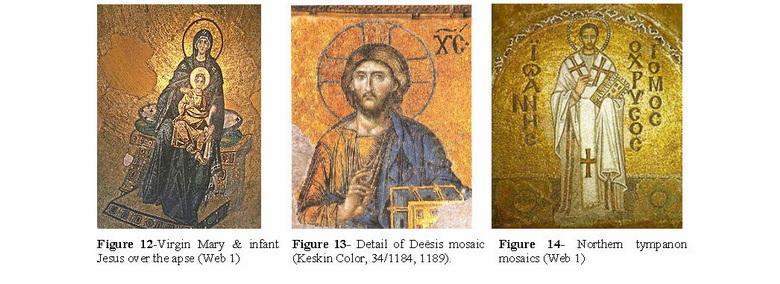
- Emperor Alexander mosaic
The Emperor Alexander mosaic is not easy to find for the first-time visitor, located in the second floor in a dark corner of the ceiling. It depicts Emperor Alexander in full regalia, holding a scroll in his right hand and a globus cruciger in his left. A drawing by Fossati showed that the mosaic survived until 1849, and that Thomas Whittemore, founder of the Byzantine Institute of America who was granted permission to preserve the mosaics, assumed that it had been destroyed in the earthquake of 1894. Eight years after his death, the mosaic was discovered in 1958 largely through the researches of Robert Van Nice (Web 1).
- Empress Zoe mosaics (Fig 15)
The Empress Zoe mosaics on the eastern wall of the southern gallery date from the 11th century. Christ Pantocrator, clad in the dark blue robe (as always the custom in Byzantine art), is seated in the middle against a golden background, giving his blessing with the right hand and holding the bible in his left hand. On either side of his head are the monograms IC and XC, meaning Iēsous Khristos. He is flanked by Constantine IX Monomachus and Empress Zoe, both in ceremonial costumes. He is offering a purse, as symbol of the donation he made to the church, while she is holding a scroll, symbol of the donations she made. The inscription over the head of the emperor says: “Constantine, pious emperor in Christ the God, king of the Romans, Monomachus”. The inscription over the head of the empress reads as follows: “Zoë, the very pious Augusta”. The previous heads have been scraped off and replaced by the three present ones. Perhaps the earlier mosaics showed her first husband Romanus III Argyrus or her adopted son Michael IV. Another theory is that these mosaics were made for an earlier emperor and empress, with their heads changed into the present ones (Web 1).
- Comnenus mosaics (Fig.16)
The Comnenus mosaics, equally located on the eastern wall of the southern gallery, date from 1122. The Virgin Mary is standing in the middle in a dark blue gown. She holds the child Christ on her lap. He gives his blessing with his right hand while holding a scroll in his left hand. On their right side stands Emperor John II Comnenus, represented in a garb embellished with precious stones. He holds a purse, symbol of an imperial donation to the church. Empress Irene stands on the left side of the Virgin, wearing ceremonial garments and offering a document. Their eldest son Alexius Comnenus is represented on an adjacent pilaster. He is shown as a beardless youth, probably representing his appearance at his coronation aged seventeen. In this panel one can already see a difference with the Empress Zoe mosaics that is one century older. There is a more realistic expression in the portraits instead of an idealized representation. The empress is shown with plaited blond hair, rosy cheeks and grey eyes, revealing her Hungarian descent. The emperor is depicted in a dignified manner (Web 1).
5. 20th CENTURY CONSERVATION STUDIES FOR HAGIA SOPHIA
The World Monuments Fund (WMF) placed Hagia Sophia on 1996 /1998 for monitoring. The deteriorated lead roof had caused water leaking down over the fragile frescoes and mosaics. With the help of financial services company American Express, WMF, secured a series of grants from 1997 to 2002 for the restoration of the dome.
The first stage of work involved the structural stabilization and repair of the cracked roof, which was undertaken with the participation of the Turkish Ministry of Culture. The second phase, the preservation of the dome’s interior, afforded the opportunity to employ and train young Turkish conservators in the care of mosaics. And, by 2006, the WMF project was completed. The six winged seraphs in the pendentives of the dome were left uncovered but their faces covered with a mask. But one of them has been uncovered during the last century restoration studies at 2009.
In these restoration studies, the figure mosaic in the central circle probably still remain behind Islamic: but for the rest of the dome the ribs and narrow spaces between only allowed of diaper work in colour on a gold ground. At present, though a good deal of mosaic is still exposed to view, the greater part is covered with plaster or a mask, which is coloured like gold and has patterns painted on it often, if not generally, reproducing the mosaic pattern behind.
6. CONCLUSIONS
Famous in particular for its massive dome, it is considered the epitome of Byzantine architecture and is said to have “changed the history of architecture” (Simons, 1993). In 1453, Constantinople was conquered by the Ottoman Turks under Sultan Mehmed II, who subsequently ordered the building converted into a mosque. The bells, altar, iconostasis, and sacrificial vessels were removed and many of the mosaics were plastered over. Islamic features – such as the mihrab, minbar (Fig 6-7), and four minarets (Fig. 4, 9) – were added while in the possession of the Ottomans. For almost 500 years the principal mosque of Istanbul, Hagia Sophia served as a model for many other Ottoman mosques, such as the Sultan Ahmed Mosque (Blue Mosque of Istanbul), the Şehzade Mosque, the Süleymaniye Mosque, the Rüstem Pasha Mosque and the Kılıç Ali Paşa Mosque. It remained a mosque until 1931 when it was closed to the public for four years. It was re-opened in 1935 as a museum by the Republic of Turkey.
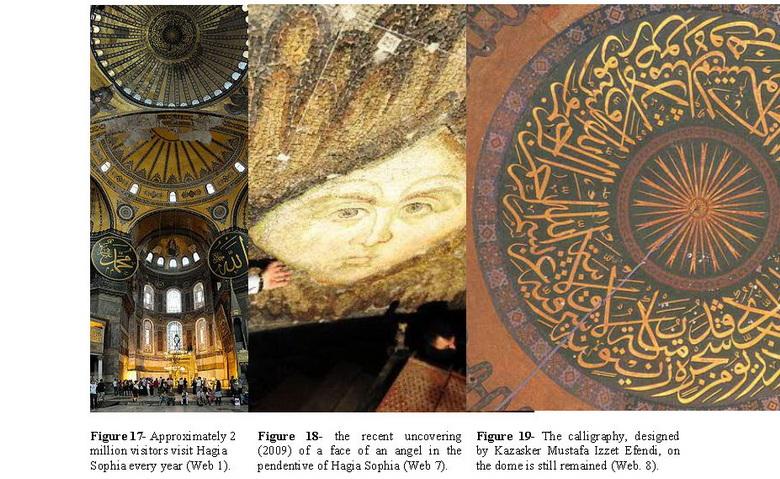 Because of its long history as both a church and a mosque, a particular challenge arises in the restoration process. The Christian iconographic mosaics are being gradually uncovered. However, in order to do so, important, historic Islamic art would have to be destroyed. Restorers have attempted to maintain a balance between both Christian and Islamic cultures. In particular, much controversy rests upon whether the Islamic calligraphy which is often called the art of fancy lettering on the dome of the cathedral should be removed, in order to permit the underlying Pantocrator mosaic of Christ as Master of the World, to be exhibited (assuming the mosaic still exists).
Because of its long history as both a church and a mosque, a particular challenge arises in the restoration process. The Christian iconographic mosaics are being gradually uncovered. However, in order to do so, important, historic Islamic art would have to be destroyed. Restorers have attempted to maintain a balance between both Christian and Islamic cultures. In particular, much controversy rests upon whether the Islamic calligraphy which is often called the art of fancy lettering on the dome of the cathedral should be removed, in order to permit the underlying Pantocrator mosaic of Christ as Master of the World, to be exhibited (assuming the mosaic still exists).
According to Venice Carter; Article 11 of the 2nd International Congress of Architects and Technicians of Historic Monuments, which met in Venice from May 25th to 31st , 1964;
The valid contributions of all periods to the building of a monument must be respected, since unity of style is not the aim of a restoration. When a building includes the superimposed work of different periods, the revealing of the underlying state can only be justified in exceptional circumstances and what is removed is of little interest and the material which is brought to light is of great historical, archaeological or aesthetic value, and its state of preservation good enough to justify the action. Evaluation of the importance of the elements involved and the decision as to what may be destroyed cannot rest solely on the individual in charge of the work.
Today, Approximately 2 million visitors visit Hagia Sophia every year to see the recent uncovering mosaics. Safeguarding this unique and irreplaceable property requires establishing effective management, against to unexpected dangers. Finally, Hagia Sophia, to whatever peoples it may belong, should be preserved with all superpose richness and values, for the well equipped restorations.
ACKNOWLEDGMENTS
Thanks to architects; Anthemios and Isidore who were created scientific and sufficient original design and construction of greatest testimony that has survived though so many disasters, and is still standing after a lapse of nearly 14 centuries. And thanks to Ottoman Emperors who ordered to protect Ayasofya for the future generations. Thus, Hagia Sophia is an unquestionably remains one of the supreme examples of the world heritage.
REFERENCES
- Avdelidis, N. P., and Moropoulou, A. (2004). “Applications of infrared thermography for the investigation of historic structures”. Journal of Cultural Heritage, 5, 1, January-March, 119-127.
- Ahunbay, M.; Z., Alnisberger, R.; Toncic, M., and İzmirligil, Ü. (1997). ”Non-destructive testing and monitoring in Hagia Sophia, Istanbul”. Studies in Ancient structures. Proceedings of The International Conference, July 14- 18, YTU Publication, Istanbul, 197-207.
- Hamilton J. A. (1933). Byzantion Architecture and decoration. B. T. Batsford Ltd., London. Hamilton J. A. (1956). Byzantion Architecture and decoration. London.
- Jackson, T. G. (1913). Byzantine and Romanesque Architecture. III, Cambridge Press, Cambridge. Jackson, T. G. (1920). Byzantine and Romanesque Architecture. II, Cambridge Press, Cambridge.
- Keskin Color, (No date).” Hagia Sophia Photographs – Album”. Keskin Colour Ltd. Sti. 34/1179-1190, Istanbul. Kinross, L. (1972).”Hagia Sophia: A history of Constantinople”. Newsweek. 132–133.
- Kucukkaya, A. G. (2003). “Conservation of superpose archaeological areas, Hippodrome, Great Palace & Sultan Ahmet Complex in Istanbul”. 5th World Archaeological Congress. Washington.
- Kucukkaya, A. G. (1987). “Mimarbasi Sedefkar Mehmet Aga’nın yasami ve Turk Osmanli Mimarisine katkisi, Un Published Ph.D. Thesis. Mimar Sinan University, Faculty of Architecture, Istanbul.
- Kucukkaya, A. G. (1992). “Orijinal fonksiyonunu yitirmis bir yapi-Sultan Ahmet Arastasi”. Yapi Dergisi. 3, 63-68. Kucukkaya, A. G. (2003). “Conservation in Ottoman Architecture-Hagia Sophia”. Free Archaeology lecture., June
- 28th 2003, Littleton City Hall, Denver, USA, http://www.littletongov.org/news/ltnreports/2003/Jun03.pdf
- Kucukkaya, A. G. (2011). “Conservation of Turkish Ottoman Architecture”. eNewsletter, 3, 1, p. 2 and 7, Durban, SA. http://coh.ukzn.ac.za/Libraries/Newsletters/Online_Newsletter_June_2011.sflb.ashx?download=false
- Mango, C. (1978). Byzantine Architecture. Milan. Murray, J. (1969). Sailing to Byzantium. London.
- Mamboury, E., and Wiegand Th. (1933). Kaiser Palaste Von Konstantinopel. Istanbul. Melling, M. (1919). Voyage pittoresque de Constantinople et de river du Bosphore. Paris.
- Simons, M. (1993). “Center of Ottoman power”. New York Times. 22 August 1993,http://www.nytimes.com/1993/08/22/travel/center-of-ottoman-power.html. Retrieved 4 June 2009.
- Stewart, C. (1947). Byzantine legacy. Georgie Allen & Unwin Ltd., London.
- Poster. (2000). “Byzantine Istanbul at 11th Century”, Published by Chambers of Turkish Architect, Ankara.
- Ulgen, (1939). Constantinople, during the era of Mohammed the conqueror. 1453-1481. Publication of the General Direction of Pious Foundations (Evkaf). Turkish Foundations Deeds, II, Ankara.
- UNESCO, (1956). Recommendations on international principles applicable to archaeological excavations. New Delhi.
- Web 1. Wikipedia, http://en.wikipedia.org/wiki/Hagia_Sophia#Mosaics
- Web 2. “Thomas Whittemore”, http://en.wikipedia.org/wiki/Thomas_Whittemore Web 3. http://tr.wikipedia.org/wiki/Ayasofya
- Web 4. “A monumental struggle to preserve Hagia Sophia”, Smithsonian Magazine. December 2008, http://www.smithsonianmag.com/travel/Fading-Glory.html#
- Web 5. http://www.hagiasophia.com/listingview.php?listingID=3
- Web 6. http://www.hagiasophia.biz/mosaics.htm
- Web 7. “Three more angels appear in Hagia Sophia”. Hurriyet Daily News. August 25 2011, http://www.hurriyetdailynews.com/n.php?n=three-more-angels-for-hagia-sophia-2009-07-26
- Web 8. Hat San’atından Ornekler. http://ismek.ibb.gov.tr/ismek-el-sanatlari- kurslari/webedition/File/ekitap/hatsanati/Hat_sberk_4.pdf
- Wiener, M. (1977). Bildlexikon zur topographie Istanbuls. Tübingen Deutsches Archaologisches Institut, Istanbul.
1 Yeditepe University, Faculty of Eng. & Architecture, Dept. of Architecture, Kayistagi, Istanbul, Turkey, kucukkaya@mailcity.com
2 Trakya University, Faculty of Eng. & Architecture, Department of Architecture, Edirne, Turkey, sadumans@yahoo.com
- Conservation of dome mosaics of Hagia Sophia in Istanbul - 24 Kasım 2022
- 3 Dilde Resimli Mimarlık ve Restorasyon Terimleri Sözlüğü - 29 Mayıs 2022
- Babaeski Semiz Ali Paşa Külliyesi - 29 Mayıs 2022
- Integration of Historic Landmarks into New City Concept in Edirne, Turkey - 29 Mayıs 2022
- Origin of Turkish Architecture Turkish Pointed Arches (Türk Mimarisinin Kökenleri ve Türk Sivri Kemeri) - 12 Aralık 2021
FACEBOOK - YORUM YAZ
BUNLAR DA İLGİNİZİ ÇEKEBİLİR
BU MAKALELER İLGİNİZİ ÇEKEBİLİR!
- YENİ

